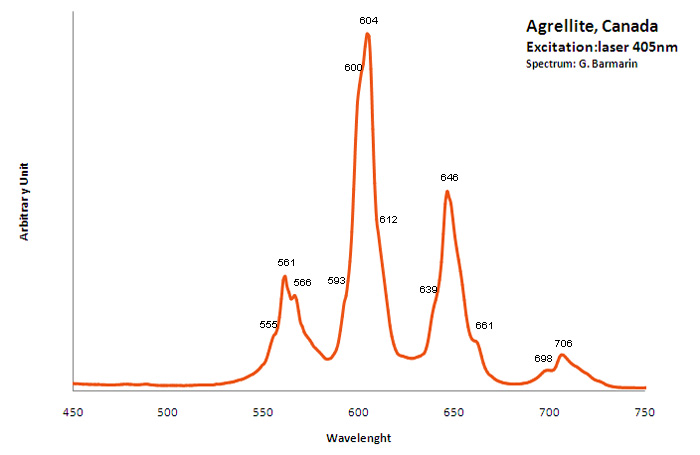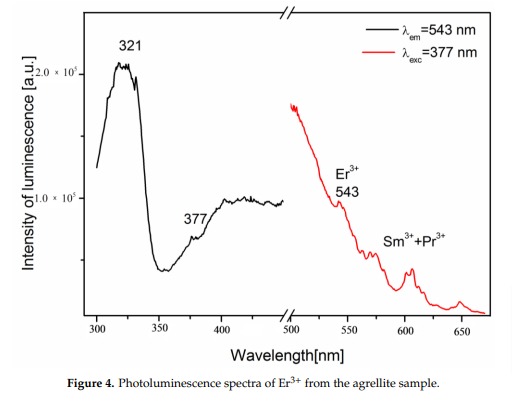Base de données des minéraux luminescents
AGRELLITE
Formule chimique: NaCa2Si4O10F
Famille: Silicates
Statut: IMA-A
Système cristallin : Triclinique
Minéral de vitrine: OUI
Luminescence:
Couleurs UV longs (365nm): |
Rose , | ||
Intensité OL:Très faible | |||
Couleurs UV moyens (320nm): |
Rose violacé , | ||
Intensité OM:Forte | |||
Couleurs UV courts (254nm): |
Rose violacé , | ||
Intensité OC:Moyenne | Fréquence OC:Toujours | ||
Photo en lumière du jour

AGRELLITE, Kipawa River, Quebec, Canada;
Photo and Copyright: James Hamblen
Site of the author
Used with permission of the author
Photo Ondes Courtes (254nm)

AGRELLITE, Kipawa River, Quebec, Canada;
OC (254 nm).
Photo and Copyright: James Hamblen
Site of the author
Used with permission of the author
Vous avez une photo de ce minéral que vous voudriez voir figurer dans la galerie? Contactez-nous!
Phosphorescence (au sens commun du terme) observable à l'oeil nu:
Type d'UV |
Couleur |
Intensité |
Fréquence d'observation |
|---|---|---|---|
UV longs (365nm): | Aucune perceptible par l'oeil | UV moyens (320 nm): | Aucune perceptible par l'oeil | UV courts (254 nm): | Blanc jaunâtre (crème) | Moyenne |
Commentaires:
Parfois associée à : hyalite (fluo verte SW), VLASOVITE (fluo jaune-orange SW), feldspath (fluo rouge SW), Eudyalite rouge, mosandrite brune; Très faible fluorescence en UVOL mais très marquée si l'on utilise un laser à 405nm; Des écantillons de Darai-Pioz Glacier, Tajikistan. présentent 4 couleurs de fluorescence aux UV courts: il s'agit de Baratovite (blanc-bleuté SW), d'agrellite (rose violacé SW) de microcline (magenta SW) et d'un minéral non déterminé, peut-être de l'hyalite contaminée par des ions uranyles (vert SW).
Activateur(s) et spectre(s):
Activateur(s): Mn2+ , Fe3+, Eu2+, Ce3+, Sm3+, Dy3+, Nd3+, Gd3+,
Pics dans le spectre (nm):
Mn2+ replacing Ca2+: Large band peaking at 580nm
Eu2+: 410nm
Sm3+: 560, 597, 602, 640nm
Dy3+: 475, 485, 580nm
Fe3+ replacing Si4+: 740nm
Nd3+(?): 955nm
Ref. sample: (555), (561), 566, (593), (600), 604, (612), (639), 646, 661, 698 and 706 nm

Agrellite, Canada. Excitation: laser 405nm. Col. G. Barmarin; Spectre: G. Barmarin
Galerie de spectres:



 ...
...  Accès à la galerie complète (8 images au total)
Accès à la galerie complète (8 images au total)
Commentaires sur les spectres et les activateurs (*):
A brief but distinctive orange flash is seen before the magenta luminescence (typical of Mn activator?). There is sometime a green fluorescent mineral accompagning agrellite. It is sometime reported as thorium activated calcite (???) that will glow green sw and mw whitish green lw and will phos under all 3 waves. Sometime thorite coating are invoqued to explain the green fluorescence in specimens from Kipawa. Albite fluorescing red SW is also often present. The emission centers observed in agrellite samples vary depending on their geographical origin. Here is a summary of the findings: Kipawa River Samples: Yakutia Samples: Dara-i-Pioz Samples: Additionally, recent spectroscopic investigations of agrellite samples from Dara-i-Pioz (Tajikistan) and Murun massif (Russia) have shown luminescence from Ce³⁺ and EPR spectra of Mn²⁺. However, it is noted that some expected emissions were not observed in certain samples. For instance, the luminescence of Mn²⁺ and Eu²⁺ was not observed in some specimens
RE elements (RRE2+ and RRE3+) replacing Ca2+ are suspected as activators. Also Mn and Fe.
Fluorescence: pink LW after Robbins and other authors, clearly visible with pointer-laser @405nm.
As with other minerals activated by RRE, the shape of the spectrum is strongly influenced by the resolution of the spectrometer because RRE have a lot of very narrow peaks very close from each other. If the resolution of the spectrometer is not sufficient, the pikes are agglomerated in larger entities.
(*)Les commentaires sur les spectres sont uniquement rédigés en Anglais
Meilleure(s) localité(s) pour la fluorescence (*):
- Mt Kipawa Complex, Kipawa River, Sheffield Lake, Villedieu Township, Québec, Canada;
- Darai-Pioz (Dara-i-Pioz) Glacier, Alai (Alayskiy) Range, Tien Shan Mts, Region of Republican Subordination, Tajikistan;
- Kedrovyi alkaline Massif, Murunskii Massif, Chara and Tokko Rivers Confluence, Aldan Shield, Sakha Republic (Yakutia), Eastern-Siberian Region, Russia;
- Wausau Complex in Marathon County, Wisconsin, USA
(*)Les données ne sont pas exhaustives et sont limitées à quelques localités remarquables pour la fluorescence
Référence bibliographique pour la luminescence:
- The Henkel Glossary of Fluorescent Minerals, Dr. Gerhard Henkel, Published by the FMS, 1989 ,
- Fluorescence: Gems and Minerals Under Ultraviolet Light, Manuel Robbins, 1994, Geoscience Press, ISBN 0-945005-13-X ,
- The World of Fluorescent Minerals, Stuart Schneider, Schiffer Publishing, 2006, ISBN 0-7643-2544-2 ,
- Luminescence Spectroscopy of Minerals and Materials, M. Gaft, R. Reisfeld, G. Panczer, Springer Editor, ISBN: 10 3-540-21918-8 ,
- Luminescent Spectra of Minerals, Boris S. Gorobets and Alexandre A. Rogojine, Moscow, 2002 ,
- Luminescenza nel regno minerale, Guido Mazzoleni, fotografia Roberto Appiani, Libri Sandit, 2010, ISBN 978-88-95990-63-7 ,
Référence pour la luminescence sur internet:
- http://www.turnstone.ca/rom94soa.htm
- https://www.mindat.org/min-57.html
- http://www.handbookofmineralogy.com/pdfs/agrellite.pdf
- Luminescence of Agrellite Specimen from the Kipawa, River Locality, Maria Czaja and Radosław Lisiecki
- UV Waves January/February 1996
- Projet Terres Rares au Québec
- Geonieuws January 2010
- Agrellite fluorescence by Bob Fosbury on Flickr and https://www.flickr.com/photos/bob_81667/6694411183/
Images:
- Kipawa, Canada, SW: https://www.mindat.org/photo-75962.html
- Kipawa, Canada, SW: https://www.mindat.org/photo-602666.html
- Kipawa, Canada, LW: https://www.mindat.org/photo-666389.html
Videos:
- On Nature Rainbows or on Youtube (same)
Référence minéralogique sur internet:
 http://www.mindat.org/show.php?name=Agrellite
http://www.mindat.org/show.php?name=Agrellite
 http://webmineral.com/data/Agrellite.shtml
http://webmineral.com/data/Agrellite.shtml
Recherche sur Internet:
 Recherche d'images sur 'Google Image'
Recherche d'images sur 'Google Image'
 Recherche de documents en français sur Google
Recherche de documents en français sur Google
 Recherche de documents en toutes
langues sur Google
Recherche de documents en toutes
langues sur Google
Une requête ne donnant pas de résultat signifie uniquement qu'aucune référence de ce type n'existe dans la base mais en aucun cas qu'elle n'existe pas dans l'absolu. Si vous considérez avoir trouvé une erreur ou une omission, merci de nous le signaler via la page contact en n'oubliant pas de citer la source de l'information.
